Flight Design CT
| CT series | |
|---|---|
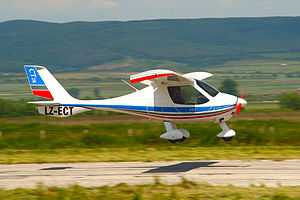 | |
| CT2K | |
| Role | Microlight/Ultralight |
| Manufacturer | Flight Design |
| Designer | Matthias Betsch |
| First flight | March 1996 |
| Introduction | 1997 |
| Status | In production |
| Produced | 1997–present |
| Number built | 900+ |
| Unit cost | |
| Variants | Flight Design MC |
The Flight Design CT series is a family of high-wing, tricycle undercarriage, two seat, ultralight and light-sport aircraft produced by Flight Design (Flightdesign Vertrieb) of Germany. The family includes the original CT and the CT2K, CTSW, CTLS and the new MC models.[2]
Design and development
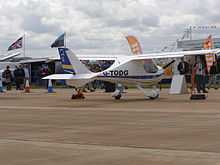
All models in the series mount a 80 hp (60 kW) Rotax 912UL or 100 hp (75 kW) Rotax 912ULS engine in tractor configuration.[1]
The aircraft are of composite construction, with carbon fiber being the primary material. This allows a very aerodynamic shape to the fuselage and very high useful loads (almost equal to the weight of the aircraft itself).[2]
One reviewer of the CT2K writing COPA Flight in October 2004 described the aircraft as "fast, comfortable, roomy and very capable of long cross country flights for little money" and faulted the aircraft only for its difficulty slowing down from its cruise speed of 130 knots to its final approach speed of 50 knots, requiring careful planning to lose 80 knots between entering the circuit and stabilizing the aircraft on final approach.[2]
Although the standard and required equipment varies by country, the CTSW has a standard Ballistic Recovery Systems parachute for the airframe. The BRS can be used to lower the entire aircraft to the ground in a controlled descent in the event of major structural failure, incapacitation of the pilot, or engine failure over mountainous terrain.[3]
Regulatory categories
The aircraft can be flown under the microlight/ultralight regulations of several countries as well as the USA FAA Light-sport Aircraft rules, Canadian advanced ultralight[2] and the European EASA Permit to Fly rules.[1]
In December 2009 the CTLS was granted a type design approval and a production certificate by the Civil Aviation Administration of China,[4] and in 2015, a CTLS production plant was constructed in China.[5]
Operational history
As of June 2012, there were 344 CTs registered in the USA, 18 in Canada and 76 in the United Kingdom.[6][7][8]
One example was used by the Indian Air Force in a round-the-world expedition.[9] Wing Commander Rahul Monga started off on 1 June 2007 and finished the circumnavigation flight on 19 August 2007. The total flight time logged was 247 hours.[10]
In 2010 the Air Volunteer Fire Department in Bomberos de Cuenca, Ecuador took delivery of a CTLS for use as an air support unit for fire fighting reconnaissance. The aircraft is based at Mariscal La Mar airport, 8,300 feet above sea level.[11]
Variants

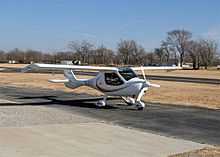
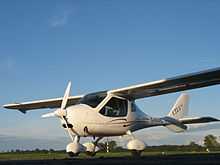
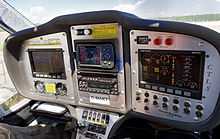
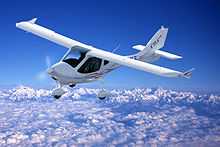
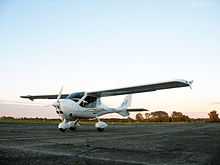
- CT
- Composite Technology - original model, production commenced in 1997.[2]
- CT2K
- Improved second generation model introduced in 1999 for the year 2000 (2K) to comply with UK microlight regulations, BCAR Section S[2]
- CTSW
- Short Wing version of the CT2K with a shorter wingspan and redesigned wingtips, giving higher cruise speeds while maintaining similar stall speeds.
- CTLS
- Light Sport version, announced in 2008. It improves on the CTSW in several areas, including a revised fuel system (improved fuel venting and standard-type fuel caps), a revised tailplane and upgraded landing gear as well as aerodynamic improvements.[1][12]
- MC
- Metal Concept is a CT-LS fabricated predominantly from steel tubing and aluminium and intended for the flight training market. Introduced in July 2008, the MC has a lower cockpit sill for easier entry, is 5-7 knots slower than the LS, has 50 lb (23 kg) less useful load and 500 mi (805 km) less range.[1][13]
- CTLS-Lite
- CTLS with reduced features, lower empty weight and price US$20,000 lower. Introduced at Sun 'n Fun 2010.[14]
- CTHL
- High Lift variant for glider towing and floatplane use, announced at Sun 'n Fun 2010. It will be equipped with a turbocharged 115 hp (86 kW) Rotax 914 powerplant, a 12% greater wing area, a larger stabilator and a full-aircraft parachute all as standard equipment. The price is forecast to be US$14,000 higher than the CTLS[15]
- CTLE
- Law Enforcement model introduced in 2011 with stabilized camera mount underneath the wing for police surveillance aircraft use.[16]
- CTLSi
- Version of the CTLS introduced in 2012 and powered by a Rotax 912 iS engine of 115 hp (86 kW). This engine improves fuel consumption by 21%. The model has a $12,800 higher price, but that includes the new engine, electric trim and a lithium ion battery.[17]
- CT Supralight
- Model for the Fédération Aéronautique Internationale microlight category, with a gross weight of 472.5 kg (1,042 lb). The standard engines for this version are 80 hp (60 kW) Rotax 912UL, the 100 hp (75 kW) Rotax 912ULS and the 115 hp (86 kW) Rotax 914 four-stroke powerplants.[1]
Specifications (CTSW)
Data from Flight Design[18][19]
General characteristics
- Crew: 1
- Capacity: 1 passenger + 50 kg (110 lb) baggage
- Length: 6.22 m (20 ft 5 in)
- Wingspan: 8.50 m (27 ft 11 in)
- Height: 2.15 m (7 ft 1 in)
- Wing area: 9.94 m2 (107.0 sq ft)
- Empty weight: 318 kg (701 lb)
- Gross weight: 472.5 kg (1,042 lb)
- Max takeoff weight: 600 kg (1,323 lb)
- Fuel capacity: 126 l (28 imp gal), 120 l (26 imp gal) usable
- Powerplant: 1 × Rotax 912S 4-cylinder, 4-stroke liquid/air-cooled engine, 75 kW (101 hp)
Performance
- Maximum speed: 230 km/h (143 mph; 124 kn)
- Cruising speed: 207 km/h (129 mph; 112 kn)
- Stall speed: 65 km/h (40 mph; 35 kn)
- Never exceed speed: 301 km/h (187 mph; 163 kn)
- Range: 1,266 km (787 mi; 684 nmi)
- Service ceiling: 4,572 m (15,000 ft)
- Rate of climb: 4.9 m/s (960 ft/min)
- Wing loading: 61 kg/m2 (12 lb/sq ft)
- Power/mass: 0.076 hp/lb (0.120 kW/kg)
See also
- Aircraft of comparable role, configuration and era
- 3Xtrim 3X55 Trener
- Evektor SportStar
- Ikarus C42
- Pipistrel Alpha Trainer
- Remos GX
- Tecnam P2008
- Tecnam P2004 Bravo
References
- ↑ 1.0 1.1 1.2 1.3 1.4 1.5 Bayerl, Robby; Martin Berkemeier; et al: World Directory of Leisure Aviation 2011-12, page 50-51. WDLA UK, Lancaster UK, 2011. ISSN 1368-485X
- ↑ 2.0 2.1 2.2 2.3 2.4 2.5 Hunt, Adam: One of aviation’s best kept secrets - Flight Design CT2K – Flight report, COPA Flight page C-1. Canadian Owners and Pilots Association, October 2004
- ↑ Flight Design (n.d.). "Standard Equipment". Retrieved 2 January 2011.
- ↑ Grady, Mary (December 2009). "Flight Design LSAs Approved In China". Retrieved 2009-12-03.
- ↑ Grady, Mary (7 April 2015). "Flight Design To Start Manufacturing In China". avweb.com. Aviation Publishing Group. Retrieved 7 April 2015.
- ↑ Federal Aviation Administration (June 2012). "Make / Model Inquiry Results". Retrieved 18 June 2012.
- ↑ Transport Canada (June 2012). "Canadian Civil Aircraft Register". Retrieved 18 June 2012.
- ↑ Civil Aviation Authority (United Kingdom) (June 2012). "GINFO Search Results Summary". Retrieved 18 June 2012.
- ↑ Indian Air Force Round the Globe Expedition
- ↑ Indian Air Force Round the Globe Expedition - Executed Itinerary
- ↑ Grady, Mary (December 2010). "LSA To Fight Fires In Ecuador". AvWeb. Retrieved 30 December 2010.
- ↑ Flight Design (December 2009). "CTLS" (PDF). Retrieved 8 December 2010.
- ↑ Grady, Mary (July 2008). "Flight Design Introduces Metal Version Of CT LSA". Retrieved 2010-01-21.
- ↑ Grady, Mary (April 2010). "Flight Design Keeps On Designin'". Retrieved 14 April 2010.
- ↑ Grady, Mary (April 2010). "Flight Design Details New Model Features". Retrieved 14 April 2010.
- ↑ Niles, Russ (25 January 2012). "Video: CTLE Light Sport Police Aircraft". AVweb. Retrieved 16 February 2012.
- ↑ Grady, Mary (27 March 2012). "Flight Design Moving Forward With New Projects". AVWev. Retrieved 28 March 2012.
- ↑ Flight Design (n.d.). "Performance". Retrieved 18 June 2012.
- ↑ Flight Design (n.d.). "CTSW" (PDF). Retrieved 18 June 2012.
External links
| Wikimedia Commons has media related to Flight Design CT. |
| ||||||||||||||
| ||||||||||||||||||||||